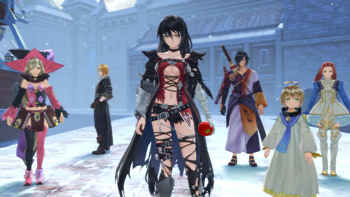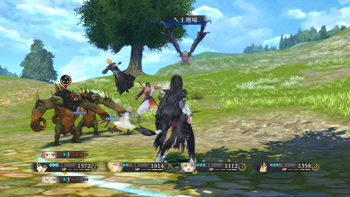Tales of Berseria Review
Love. Family. Betrayal. One of these words do not fit with the others, but in this newest installment of the Tales series, it made its impact.
Tales of Berseria is the newest installment of the Tales series, more specifically the 16th main entry into the series, developed and published by Bandai Namco Studios. It was first released in Japan in August 2016, but has now been released worldwide for Microsoft Windows and Playstation 4 as of 27 January 2017. Development had started shortly after the active development had finished for Zestiria, and is the first official title that has been developed for the PS4, however Japan received a PS3 release of the game on 18 August 2016. Tales of Berseria acts as the prequel to Tales of Zestiria.
He did WHAT!?

As a big fan of anime, I knew I was going to be enjoying this game. Even from the start menu, I was given the chance to choose between English and Japanese audio. Being true to my anime roots, I chose Japanese for the most part, keeping up with the English subtitles just fine, but I opted a few times when launching the game again to give the English audio a try. I’m usually not impressed with English dubs, but the voice actors did a pretty good job in this game, and captured the personalities of the characters quite well. Once I had chosen my audio language and launched the game, it pretty much jumped straight into chaos as the beginning cinematic played, introducing you to Artorius, Velvet and Laphicet. I knew nothing about the game going in, and I must say, I did not expect Artorius’s betrayal, (heck, even I felt betrayed!) which got me even more involved in the game, wanting to give Velvet her chance at Vengeance.
The power that Velvet acquires by becoming a daemon is quite intense, almost as if it embodied her rage and took a physical form on her arm. I have to be honest though, I would not go so far as to calling the monsters, Velvet, and other characters daemons. Most of the “daemons” just look like monsters, more specifically, Werewolves, Lizardmen, Zombies, Orcs, etc. while the other characters, which includes Velvet, had slight mutations, but kept their human form.
It’s been a While…
I will admit, the last time I played a Tales game was back when Tales of the World was released, and Reid from Tales of Eternia was a Swordsman who I could get tips and such from. That was years ago, but fortunately, even though I am playing a game far forward in the timeline of the Tales series games, it did not feel like I was missing any information going into the game. The objectives were made clear through the story-line, so it’s safe to say that there is no obligation for you to play any previous installments of the series to understand what is going on. It’s a fresh start that will most likely pull you further into the world of the Tales’ series like it has with me. Every time I found a save point I thought to myself “just a little longer.”, because I wanted to find out what was going to happen next in the story.

I’m guessing you’re thinking “That’s a heckload of grinding!”. To which I reply, yes, it is. Fights become tedious and boring after a while, but it is recommended to be able to loot items that will be used for enhancing your inventory in a later stage of the game.
The game is story-rich and filled with content, much like previous Tales games, but there are a few changes that have been made in this one. The game uses a variation of a combat system used in previous Tales titles called Liberation-Linear Motion Battle System (Libertaion-LMBS), where when you are in the battle zone, you are able to move around freely with your character and rotate the camera as you see fit. Characters fight using physical and magical attacks, called Artes, which can be mapped to the different control buttons. A key mechanic to the fighting is the Soul Gauge, which measures the amount of Artes you are able to use. You are allowed up to five souls in the gauge, which depletes as you attack, and replenishes when you don’t. Guarding during these moments is recommended, although guarding also depletes a little bit of the Gauge. You can “steal” souls when enemies have been defeated, but enemies are also able to “steal” souls from you, which reduces the amount of Artes you will be able to use.
Wait… There’s More?
The game already has Downloadable Content (DLC) available, some of which are free. You can even get Tales of Berseria themes from the PlayStation Store for free. I have one applied at the moment. It’s pretty epic. When you’re in the main menu of the game, go to the extra content section and download the Catalogs, these are for free as well. The catalogs contain skins for the characters, which are what you will need to pay for, but the catalogs also contain Adventure Item Packs that can be downloaded for free. Most of these items are only going to be used later in the game, but you infinite inventory space, so why not get a headstart? Some of the skins looked really awesome, especially for Eizen. And don’t miss out on the skits!
[review]
Conclusion
I had a lot of fun in Tales of Berseria. I am keen on trying to see if I can manage to get to Level 200 for interest’s sake, but so far, Velvet seems to be overpowered enough as it is. The story was captivating, and most of all, the characters had great personalities! Some were complex, other’s were ridiculous, but all-in-all, a lot of fun. I would have liked to have seen the game make better use of the Playstation 4’s graphic capabilities in the environments, but this didn’t ruin my experience too much. Being a fan of previous Tales games, I am glad to see the series is still going strong, with improvements having been made even.
My final thought is this… Tales of Berseria is great, but the price, not so much… The game is being sold on Steam for R757.00, and on the PlayStation Network for R1069.00. Good luck with that!

